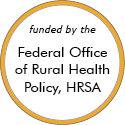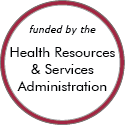Rural Project Examples: Effective
Browse rural projects that meet this collection's second highest level of evidence. For each example listed, the approach has been reported in a peer-reviewed publication.
Strong African American Families-Teen Program
Updated/reviewed May 2023
- Need: There is a lack of interventions that addresses teenager behavioral problems, particularly for rural African American adolescents.
- Intervention: Rural, locally trained leaders administered five 2-hour meetings for teenagers and their primary caregivers. Trainings focused on reducing risks that prevent positive development, specifically sexual risk-taking that can lead to HIV and other STIs.
- Results: Teens reported reduced conduct problems, depressive symptoms, and substance abuse. Families were strengthened, and SAAF-T reduced unprotected intercourse and increased condom efficacy.
Perinatal Health Partnership Southeast Georgia

Updated/reviewed February 2023
- Need: In 12 rural southeast Georgia counties, high-risk pregnant individuals potentially face adverse birth outcomes, including maternal or infant mortality, low birthweight, very low birthweight, or other medical or developmental problems.
- Intervention: An in-home nursing case management program for high-risk pregnant individuals in order to maximize pregnancy outcomes for mothers and their newborns.
- Results: Mothers carry their babies longer and the babies are larger when born, leading to improved health outcomes.
New Mexico Mobile Screening Program for Miners


Updated/reviewed December 2022
- Need: To increase access to medical screening for miners in New Mexico.
- Intervention: A mobile screening clinic with telemedicine capability screens miners for respiratory and other conditions.
- Results: In a survey, 92% of miners reported their care as very good, while the other 8% reported it as good. The program has expanded to three other states.
Farm Dinner Theater
Updated/reviewed August 2022
- Need: To encourage farmers to make health and safety changes on their farms.
- Intervention: Farm Dinner Theater is an event in which farmers and their families watch three 10-minute plays covering health and safety topics and then discuss solutions to the issues addressed in each.
- Results: In a study, farmers who attended the plays were more likely to make changes and tell others what they learned, compared to farmers who received an educational packet with the same information.
Vivir Mejor! (Live Better!) System of Diabetes Prevention and Care

Updated/reviewed August 2022
- Need: To address high rates of diabetes in rural Hispanic/Latino populations near the U.S.-Mexico border.
- Intervention: A comprehensive, culturally competent diabetes education program was implemented in Santa Cruz County, Arizona.
- Results: Since 2012, this program has helped participants better manage their diabetes and increase healthy living behaviors.
HoMBReS
Updated/reviewed February 2022
- Need: To reduce the risk of HIV/STDs among Latino men living in rural regions of the United States.
- Intervention: Soccer team leaders are elected and trained as lay health advisors to promote sexual health education among team members.
- Results: Program participants report an increase in HIV testing, an increase in condom use, and an increase in awareness of how to prevent the transmission of HIV.
Project Lazarus
Updated/reviewed November 2021
- Need: To reduce overdose-related deaths among prescription opioid users in rural Wilkes County, North Carolina
- Intervention: Education and tools are provided for prescribers, patients and community members to lessen drug supply and demand, and to reduce harm in prescription opioid use
- Results: Opioid overdose death rates have decreased in Wilkes County
NC-REACH: NC-Rurally Engaging and Assisting Clients who are HIV positive and Homeless

Updated/reviewed November 2020
- Need: Provision of medical care access and follow-up for rural North Carolina HIV patients with mental health, substance abuse, and unstable housing/homelessness challenges.
- Intervention: Medical home staff model expanded to a care coordination program with a core Network Navigator and Continuum of Care Coordinator assisting with medical, behavioral health, and basic life needs.
- Results: To date, the program has advanced three aspects of medical home patient care for this target population: provided further understanding of the spectrum of homelessness, including "hidden" homelessness; implemented outreach with creation of new community partnerships and a community housing coalition; and integrated medical care and behavioral health care for HIV.
Vermont Hub-and-Spoke Model of Care for Opioid Use Disorder
Updated/reviewed August 2020
- Need: Increase access to medication-assisted treatment for opioid use disorder in rural Vermont.
- Intervention: Statewide hub-and-spoke treatment access system.
- Results: Increased treatment capacity and care coordination.
Community Health Worker-based Chronic Care Management Program
Added May 2020
- Need: Improve healthcare access and decrease chronic disease disparities in rural Appalachia.
- Intervention: A community health worker-based Chronic Care Management program demonstrated such a level of success in a single West Virginia county that it was further scaled for implementation in a multi-center, 3-state area of Appalachia.
- Results: When analysis of the disseminated program's results also demonstrated improved health outcomes and decreased healthcare costs, sustainability became possible due to innovative financial reimbursement models.
